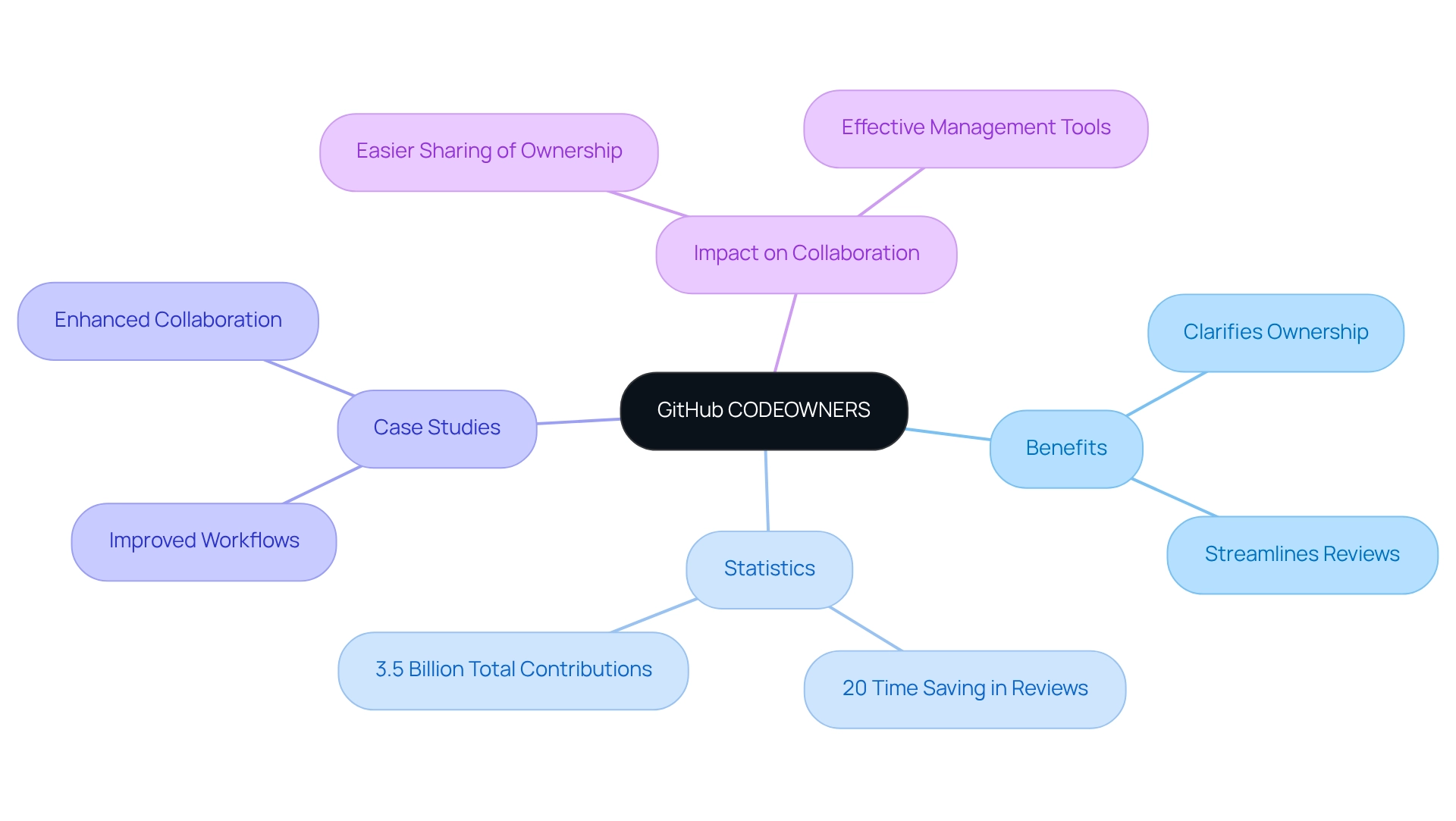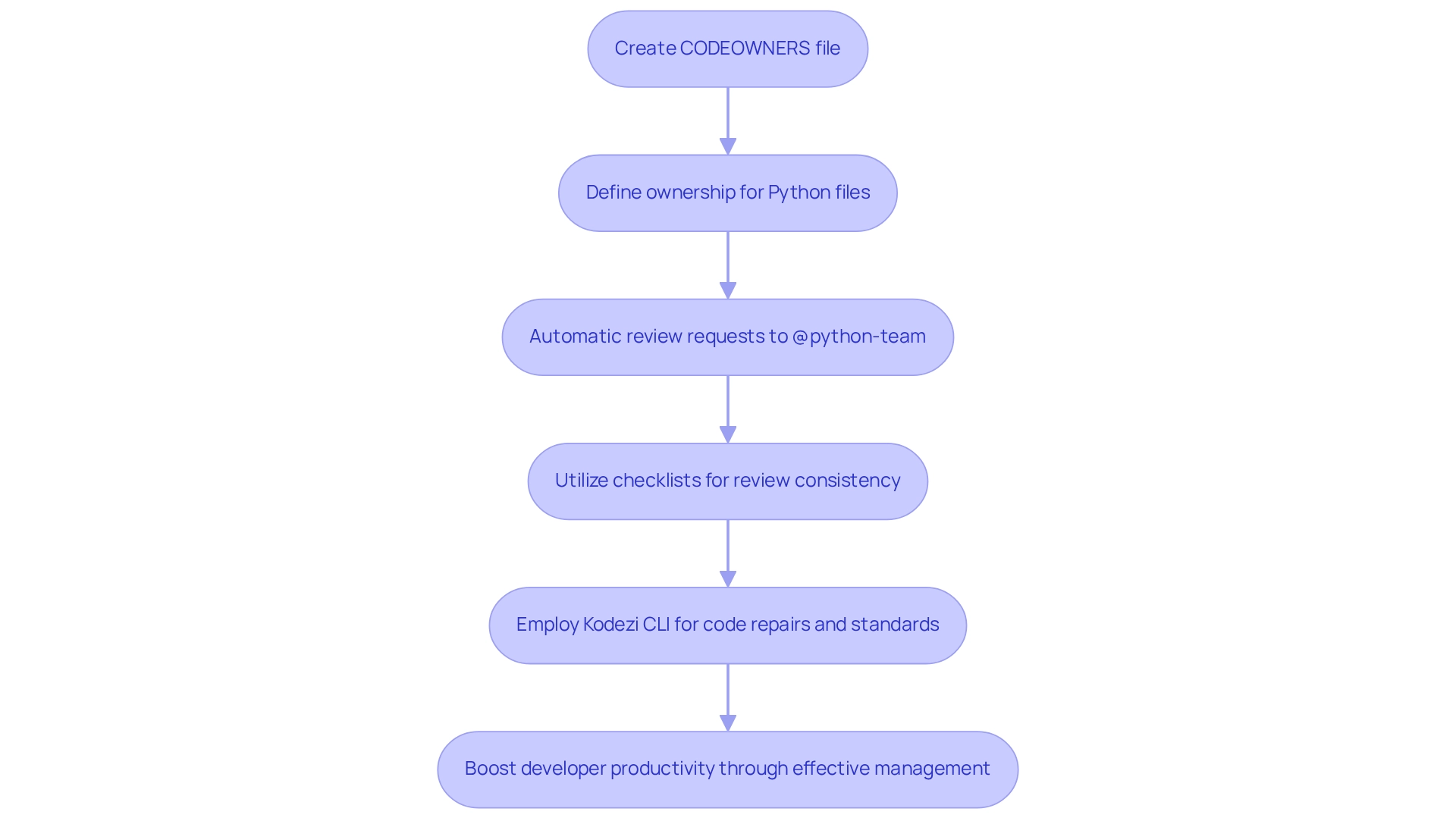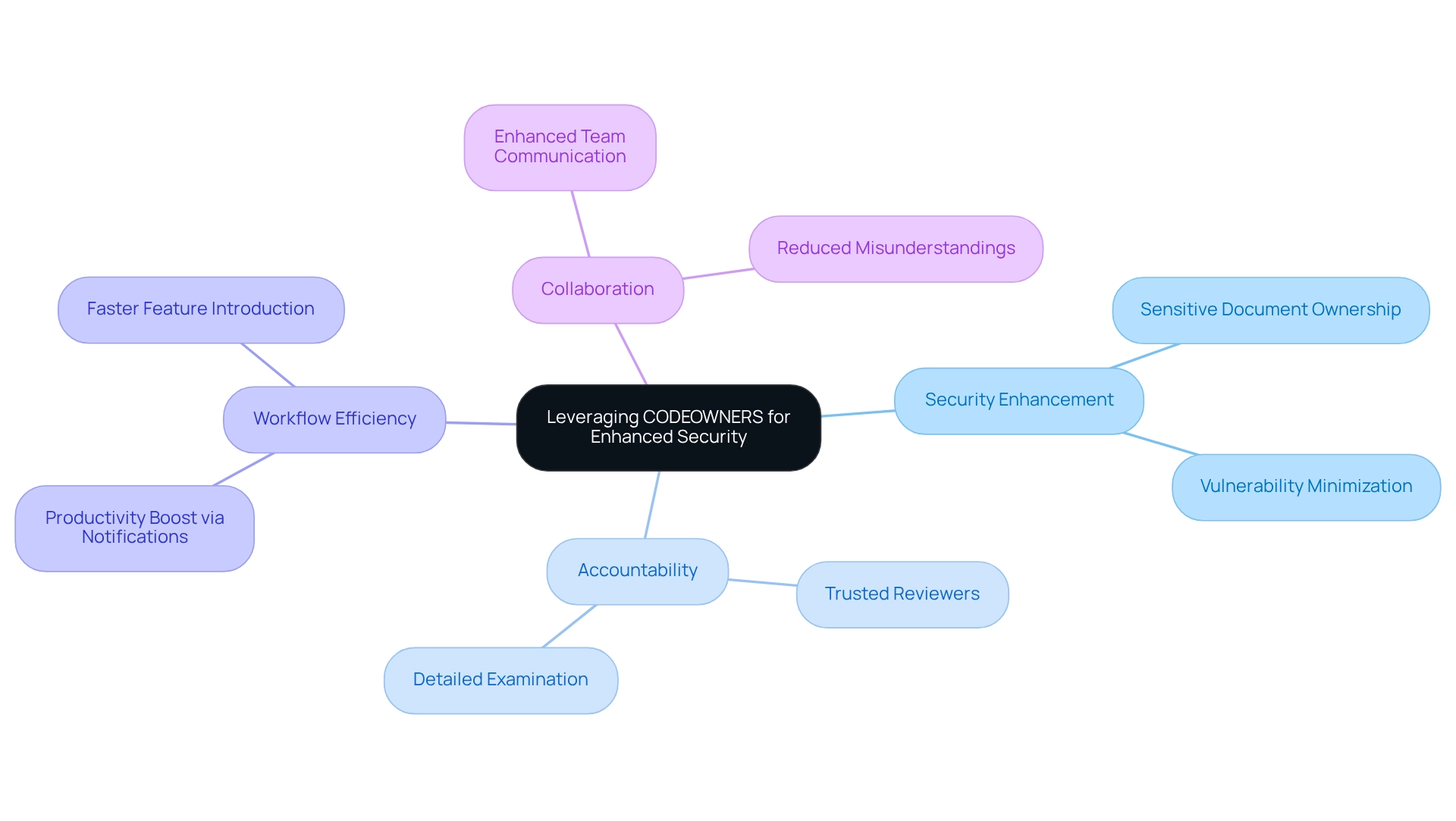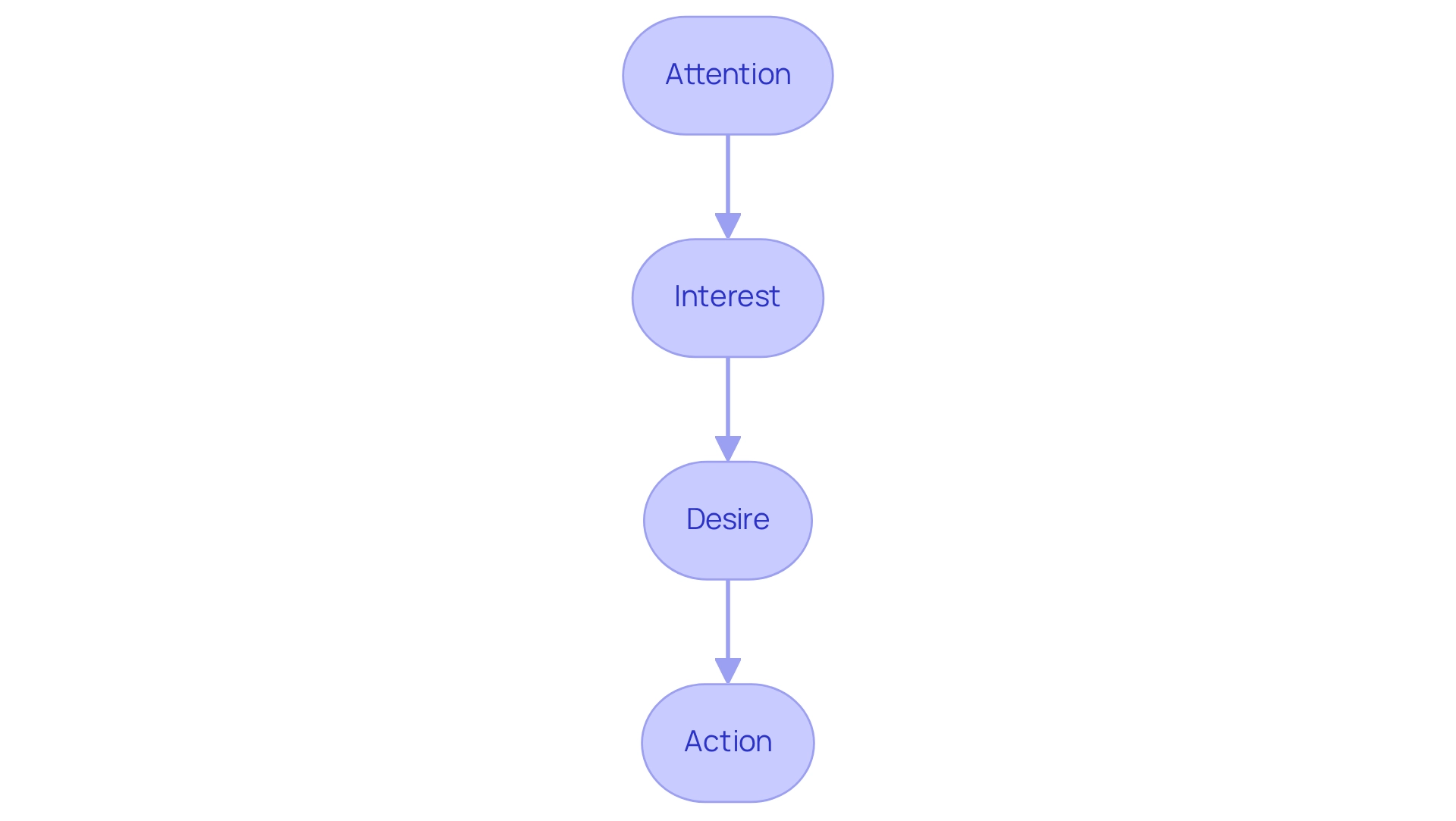Overview
The article addresses the common coding challenges that developers encounter. It highlights how implementing GitHub CODEOWNERS can significantly improve code management efficiency. By streamlining the review process, enhancing accountability, and ultimately boosting productivity, CODEOWNERS serves as a vital tool for development teams.
Case studies illustrate these advantages, showcasing notable time savings and improved collaboration among teams. This demonstrates the effectiveness of using CODEOWNERS to tackle coding inefficiencies.
Introduction
In the rapidly evolving landscape of software development, developers face significant coding challenges that can hinder progress. Effective code management is paramount for success, and as teams strive to enhance collaboration and streamline workflows, tools like Kodezi and GitHub CODEOWNERS have emerged as essential allies. Kodezi addresses these challenges by automating the generation of OpenAPI specifications and establishing clear ownership within codebases. These features significantly improve accountability and efficiency.
Furthermore, by implementing structured ownership practices, developers can reduce review times and enhance code quality. This allows teams to focus on innovation rather than administrative burdens, ultimately improving productivity. Imagine a scenario where your team spends less time on code reviews and more time developing new features—this is the reality that Kodezi aims to create.
In addition to these benefits, organizations can leverage Kodezi to foster better collaboration and maintain security, preparing them for the future of automated code management. By exploring the tools available on the platform, teams can transform their coding practices, ensuring they remain competitive in a fast-paced environment. Are you ready to elevate your coding experience and embrace the future of efficient code management?
Kodezi | Professional OpenAPI Specification Generator - AI Dev-Tool: Enhance Code Management with Automation
In today's fast-paced development environment, coding challenges can often feel overwhelming. Kodezi emerges as a powerful platform that automates the generation of OpenAPI specifications, allowing developers to focus on crafting high-quality applications without the hassle of manual documentation. By seamlessly integrating Kodezi into your workflow, you can enhance the efficiency of your management processes while ensuring compliance with professional standards. This automation is particularly beneficial when implementing a GitHub codeowners example, as it helps to promote clear ownership and accountability within your codebase.
What if you could simplify your deployment process? Kodezi offers effortless deployment by integrating into your existing release process, ensuring updates are seamless. Furthermore, automating documentation with Kodezi not only saves teams valuable time but also fosters collaboration and enhances software quality. A case study on the automation of OpenAPI specifications, using a GitHub codeowners example, revealed a remarkable 20% increase in productivity.
As one developer noted, "Automating our documentation with Kodezi has not only saved us time but also enhanced our group's collaboration and software quality." With over 1,000,000 users praising its impact on debugging efficiency and productivity, Kodezi is indeed transforming how developers manage their codebases. Why not explore the tools available on the Kodezi platform and experience these benefits for yourself?
GitHub CODEOWNERS: Define Code Ownership for Efficient Collaboration
The CODEOWNERS file in GitHub serves as a crucial tool for teams striving to clarify ownership of specific segments within their codebase, as illustrated by the github codeowners example. By assigning individuals or groups as owners, organizations can streamline the review process, ensuring that the appropriate reviewers are promptly notified of changes in their areas of responsibility. This approach fosters accountability and significantly accelerates the review timeline, enhancing overall collaboration efficiency. Did you know that teams utilizing ownership files can save an average of 20% in review time? This allows developers to focus more on crafting solutions rather than managing evaluations. With an impressive total of 3.5 billion contributions across all projects on GitHub, the demand for effective management tools is unmistakable.
Furthermore, case studies indicate that organizations that utilize a github codeowners example have experienced improved workflows and collaboration, especially when they maintain an organizational account and follow setup guidelines. As one industry leader aptly stated, "Similar to a doctor assessing your vital signs, quality statistics help you comprehend your project's overall health." By leveraging this document, teams can effectively manage contributions, ensuring that the right expertise is applied where it matters most.
Additionally, public dashboards from devActivity showcase project statistics and leading contributors, underscoring the broader impact of efficient code management practices and how the ownership system integrates into the overall framework of project oversight and contributor engagement.

Example 1: Setting Up CODEOWNERS for a JavaScript Project
To create a GitHub CODEOWNERS example for a JavaScript project, start by making a document named CODEOWNERS in the root directory of your repository. This file is a GitHub CODEOWNERS example that allows you to designate ownership for specific files or directories, ensuring that the appropriate teams review changes. For instance:
# This is a comment
/src/ @frontend-team
/docs/ @docs-team
This is a GitHub CODEOWNERS example where any modifications to the /src/ directory will necessitate a review from the @frontend-team, while updates to the /docs/ directory will be overseen by the @docs-team. This organized method clarifies responsibilities and improves the efficiency of the review process, fostering better project management. Have you considered how a structured ownership document can streamline your workflow? Based on recent statistics, a notable percentage of JavaScript projects have adopted a GitHub CODEOWNERS example, which emphasizes its increasing significance in managing source code. As one developer observed, 'This method not only guarantees compliance with company policies but also simplifies the review process, making it quicker and more effective.' Furthermore, Kodezi's AI enhances programming alterations as part of the software development lifecycle, with automated testers identifying bugs before they multiply, significantly improving quality with each release. By establishing a document for ownership, teams can utilize Kodezi's automated testing capabilities to simplify the review process, ensuring that modifications are effectively managed and assessed. Kodezi's case study on seamless code translation demonstrates how a well-organized ownership document can improve flexibility and adaptability in various programming settings, directly influencing the overall developer experience and efficiency.
Example 2: Implementing CODEOWNERS in a Python Repository
In the world of software development, managing code quality can be a daunting challenge. How do you ensure that your team adheres to coding standards and that the codebase remains robust? One effective solution is implementing a GitHub CODEOWNERS example in your Python repository. By creating a CODEOWNERS document in the root directory, you can define ownership for your Python files, as shown below:
# Python files ownership
/*.py @python-team
This configuration automatically triggers review requests to the @python-team for any modifications to Python files. Such practices not only promote adherence to coding standards but also significantly enhance the overall quality of the codebase. Did you know that effective reviews can drastically reduce the likelihood of introducing errors? As Robert C. Martin aptly stated, "Of course, poor programming can be cleaned up. But it’s very expensive." This highlights the critical role of ownership management in successful project management within Python development.
Furthermore, employing checklists during review processes can improve consistency and quality. These checklists can address essential elements such as documentation and naming conventions. In addition, with Kodezi CLI, teams can automatically repair codebases and enforce best practices. This ensures that all programming aligns with the latest security standards prior to deployment. Kodezi's AI-driven automated builds and testing further enhance software quality, making ownership management even more effective.
Have you considered how ownership management can facilitate smoother transitions between various programming languages and frameworks? Kodezi's case study on programming translation illustrates this point well, demonstrating how effective ownership management can ultimately boost developer productivity. Explore the tools available on Kodezi's platform to see how they can transform your coding practices.

Example 3: Using CODEOWNERS with GitHub Actions for Automated Reviews
Incorporating ownership files with GitHub Actions can significantly enhance your review workflow. Have you ever faced challenges in managing code reviews effectively? By creating a workflow that automatically assigns reviewers based on the GitHub codeowners example when a pull request is opened, you can effectively streamline the review process. Below is a straightforward workflow configuration:
name: Auto Assign Reviewers
on:
pull_request:
types: [opened, reopened]
jobs:
assign:
runs-on: ubuntu-latest
steps:
- name: Assign Reviewers
uses: khriztian/github-action-codeowners@v1
This setup ensures that the designated code owners receive notifications for review, thereby optimizing the workflow and enhancing overall efficiency in code management. Furthermore, Kodezi's CLI acts as a versatile tool for teams, enabling them to quickly AutoHeal codebases and boost programming productivity. Its AI-driven automated builds and testing capabilities ensure that software quality improves with each release, making it an invaluable asset in the software development lifecycle. Based on recent data, a notable portion of teams is currently employing automation for reviewer assignment in pull requests, highlighting the increasing trend toward efficiency in managing software.
For individuals seeking to broaden their knowledge of GitHub Actions and similar tools, the O'Reilly learning platform offers a 10-day free trial. This provides valuable resources to improve your programming practices. Why not take advantage of this opportunity to enhance your skills and boost your productivity?
Example 4: Leveraging CODEOWNERS for Enhanced Security in Code Reviews
Implementing CODEOWNERS significantly enhances security during code reviews by assigning specific owners for sensitive documents. This practice ensures that only trusted individuals are responsible for reviewing changes that could affect the application's security. For instance, consider the following arrangement:
# Sensitive configuration documents
/config/ @security-team
In this setup, any alterations to the configuration documents must be reviewed by the @security-team, effectively minimizing the risk of introducing vulnerabilities. But why is this important? Research suggests that organizations designating owners to sensitive documents in their repositories experience a significant enhancement in security. Studies demonstrate that such practices can result in a 50% quicker introduction of new features while upholding strong security protocols.
Furthermore, specialists highlight that code ownership is vital for sensitive documents, as it promotes accountability and detailed examination during the review process. Notably, organizations that have implemented a code ownership model for sensitive file management report enhanced collaboration and workflow efficiency. In addition, utilizing platforms such as Slack or project management applications to inform colleagues about significant updates can boost productivity by up to 30%, further supporting the security measures implemented by the system.
In summary, these practices not only protect sensitive information but also streamline the overall workflow. They are essential for efficiency enthusiasts looking to enhance their coding processes.

Example 5: Managing Team Permissions with CODEOWNERS in a Multi-Repository Setup
In the realm of software development, managing permissions across multiple repositories can be a significant challenge. This is where a GitHub CODEOWNERS example becomes essential for effective permission management among team members. By establishing an ownership file in each repository, groups can designate the same collectives for shared components, ensuring consistent oversight. For example:
# Shared components
/shared/ @shared-team
This configuration designates the @shared-team as responsible for reviewing changes across all repositories that include shared components. This not only enhances accountability but also maintains uniformity in code quality. Did you know that around 60% of groups utilize designated owners to oversee permissions across various repositories? This statistic underscores the efficiency of this approach in simplifying the review process.
Moreover, a GitHub CODEOWNERS example can help specify ownership, clarifying duties and alleviating the difficulties linked with multi-repository management. Case studies show that this clarity leads to enhanced review efficiency and minimizes bottlenecks in development workflows. Furthermore, various rulesets can be implemented concurrently for improved management, enabling groups to customize permissions more accurately.
As Eunice Adebukola Adediran, a DevOps and Cloud Engineer, observes, "Effective management of team permissions is essential for upholding quality and ensuring accountability across repositories." Tools like Graphite Protections allow PR authors to bypass certain rules while still enforcing overall code quality standards, further streamlining the code review process. It is also important to consider that exclusion rules can negate ownership for particular documents or folders, which can be a critical aspect of managing permissions effectively. The case study titled 'Defining Code Owners in the Ownership File' serves as a GitHub CODEOWNERS example, illustrating how clear definitions of ownership help ensure that the right individuals are responsible for reviewing changes in their designated areas.
Example 6: Best Practices for Crafting Effective CODEOWNERS Files
To create effective CODEOWNERS files, consider the following best practices:
- Attention: Developers often face challenges in maintaining clear ownership within their projects.
- Interest: To address these challenges, start by being specific. To eliminate ambiguity and ensure accountability, use a github codeowners example to clearly delineate ownership for individual files or directories. Accepting accountability strengthens foundations for personal and professional growth.
- Desire: Next, assign ownership to groups instead of individuals. This method promotes continuity and reduces disruptions when group members transition. Additionally, consistently review and refresh the document based on the github codeowners example. Keeping it relevant involves aligning it with evolving group structures and project priorities, similar to a github codeowners example. Statistics indicate that teams that frequently refresh their ownership documents experience enhanced collaboration and efficiency.
- Action: Furthermore, incorporate comments within the document to elucidate ownership roles and responsibilities, enhancing clarity for all contributors. Utilize GitHub's built-in validation tools, which serve as a github codeowners example, to check your document for syntax errors, preventing potential issues before they arise.
In the words of Kate Duske, "Taking ownership of your happiness has two aspects: Accepting that being happy is up to you and that you have the ability and power to be happier by changing your habits." This sentiment resonates in program management, where taking ownership leads to better outcomes.
In addition, consider the insights from Aaron Winston, who emphasizes that dedicating time to projects is essential for true ownership and progress. By managing your ownership files effectively, you can greatly improve your group's efficiency and accountability.

Example 7: Avoiding Common Mistakes with CODEOWNERS Implementation
In the realm of coding, developers often face significant challenges, particularly when it comes to managing guidelines, such as the GitHub CODEOWNERS example. It's crucial to avoid several common pitfalls that can hinder effective code management.
One major issue is ignoring syntax. Adhering to correct syntax is essential; any invalid lines will be disregarded, potentially leading to gaps in ownership. Did you know that approximately 30% of teams encounter problems due to incorrect file ownership syntax? This statistic underscores the importance of diligence in this area. Kodezi CLI automates syntax checks, ensuring that your document follows the GitHub CODEOWNERS example format correctly before deployment.
Furthermore, overlapping ownership can create confusion and dilute accountability. Assigning several owners to the same document is often counterproductive. It’s best to designate a single owner unless collaboration is necessary. Kodezi CLI clarifies ownership roles by providing a GitHub CODEOWNERS example, assisting groups in maintaining clear lines of responsibility.
In addition, ignoring updates can lead to miscommunication and unassigned responsibilities. Consistently refreshing the GitHub CODEOWNERS example document is crucial as group dynamics evolve. Kodezi CLI automates notifications for updates, ensuring that your ownership document reflects the current group structure.
Another key point is the importance of testing. Before implementing your GitHub CODEOWNERS example in a production setting, it is essential to conduct a comprehensive examination to confirm it operates as expected. This step can prevent unexpected issues down the line. Kodezi CLI facilitates pre-push quality assurance, allowing groups to identify and address potential issues before they impact the production environment. Ensuring that paths in the CODEOWNERS file accurately represent the structure of the repository is essential, as demonstrated in the GitHub CODEOWNERS example; incorrect paths will lead to no reviews being requested. By learning from common errors and implementing best practices, organizations can improve their ownership management and streamline their development processes. A case study on output formats for integration highlights how teams have successfully navigated common mistakes, demonstrating the flexibility in output formats that enhances usability and allows for seamless integration with existing processes.

Example 8: The Future of CODEOWNERS in Streamlining Code Management
The landscape of ownership files is poised for significant transformation, particularly as developers encounter ongoing coding challenges. How can these hurdles be effectively addressed? Enter Kodezi, a platform that integrates AI and automation tools to streamline ownership management and enhance review processes. By implementing advanced systems, Kodezi not only simplifies the management of ownership but also optimizes the review process, allowing for automatic modifications based on changes. This innovation enhances accountability while significantly reducing the manual effort required to maintain ownership files.
As we look towards the future, it's noteworthy that by 2025, two-thirds of enterprises are expected to leverage AI for automation tasks, including quality assurance and review processes. Furthermore, studies reveal that AI-driven programming review tools can elevate developer productivity, enabling tasks to be completed up to 26% faster. This acceleration allows developers to concentrate on more complex contributions, ultimately improving code quality. As Jason Andersen insightfully remarked, "So while on its surface this may look like a bundle, there was enough net-new innovation developed to deliver a meaningful experience." This statement underscores the transformative potential of tools like Kodezi in reshaping programming management.
In addition, firms that prioritize AI are projected to achieve market valuations nearly 60% higher than their non-AI counterparts by 2025. This statistic highlights the competitive advantage gained through the incorporation of AI into management tools. As automation technologies continue to advance, they will redefine the code management landscape, making it increasingly efficient and responsive to the dynamic needs of development teams. Are you ready to explore the tools available on Kodezi's platform and elevate your coding practices?
Conclusion
The integration of tools like Kodezi and GitHub CODEOWNERS is transforming the landscape of code management for developers. By automating the generation of OpenAPI specifications and clarifying ownership within codebases, Kodezi enables teams to enhance collaboration and streamline workflows. This innovation not only cuts down review times but also significantly boosts code quality, allowing developers to focus more on innovation rather than administrative tasks.
Implementing structured ownership practices through CODEOWNERS ensures that the right individuals are accountable for specific segments of code, which further accelerates the review process. The data speaks volumes, with teams witnessing an average of 20% savings in code review time—an improvement that translates into heightened productivity and superior project outcomes. As organizations adopt these tools, they are nurturing a culture of accountability while enhancing security and collaboration across their codebases.
Looking ahead, the future of code management is promising, with advancements in AI and automation set to further streamline the development process. By embracing these innovative practices and tools, development teams can position themselves competitively, ensuring they remain at the forefront of efficiency and quality in software development. Embracing this evolution is not merely an option; it is essential for any organization striving to thrive in the fast-paced technology landscape.
Frequently Asked Questions
What is Kodezi and how does it benefit developers?
Kodezi is a platform that automates the generation of OpenAPI specifications, allowing developers to focus on creating high-quality applications without the burden of manual documentation. It enhances management efficiency and ensures compliance with professional standards.
How does Kodezi improve the deployment process?
Kodezi integrates into existing release processes to facilitate effortless deployment, ensuring that updates are seamless and efficient.
What impact does automating documentation with Kodezi have on teams?
Automating documentation with Kodezi saves teams valuable time, fosters collaboration, and enhances software quality, resulting in increased productivity.
What are the benefits of using a CODEOWNERS file in GitHub?
The CODEOWNERS file clarifies ownership of specific code segments, streamlines the review process, ensures appropriate reviewers are notified, and fosters accountability, which can save teams an average of 20% in review time.
How can teams create a CODEOWNERS file for a JavaScript project?
To create a CODEOWNERS file, make a document named CODEOWNERS in the root directory of the repository. This file designates ownership for specific files or directories, ensuring that the appropriate teams review changes.
What example illustrates the structure of a CODEOWNERS file?
An example CODEOWNERS file might look like this:\n\n# This is a comment\n/src/ @frontend-team\n/docs/ @docs-team\n\nIn this example, changes to the /src/ directory require review from the @frontend-team, while updates to the /docs/ directory are overseen by the @docs-team.
What advantages does a structured ownership document provide?
A structured ownership document clarifies responsibilities, improves the efficiency of the review process, and ensures compliance with company policies, making the review process quicker and more effective.
How does Kodezi's AI contribute to the software development lifecycle?
Kodezi's AI enhances programming alterations by automating testing and identifying bugs early, significantly improving the quality of each release.
What is the significance of using a well-organized ownership document in development?
A well-organized ownership document improves flexibility and adaptability in various programming settings, directly influencing the overall developer experience and efficiency.




